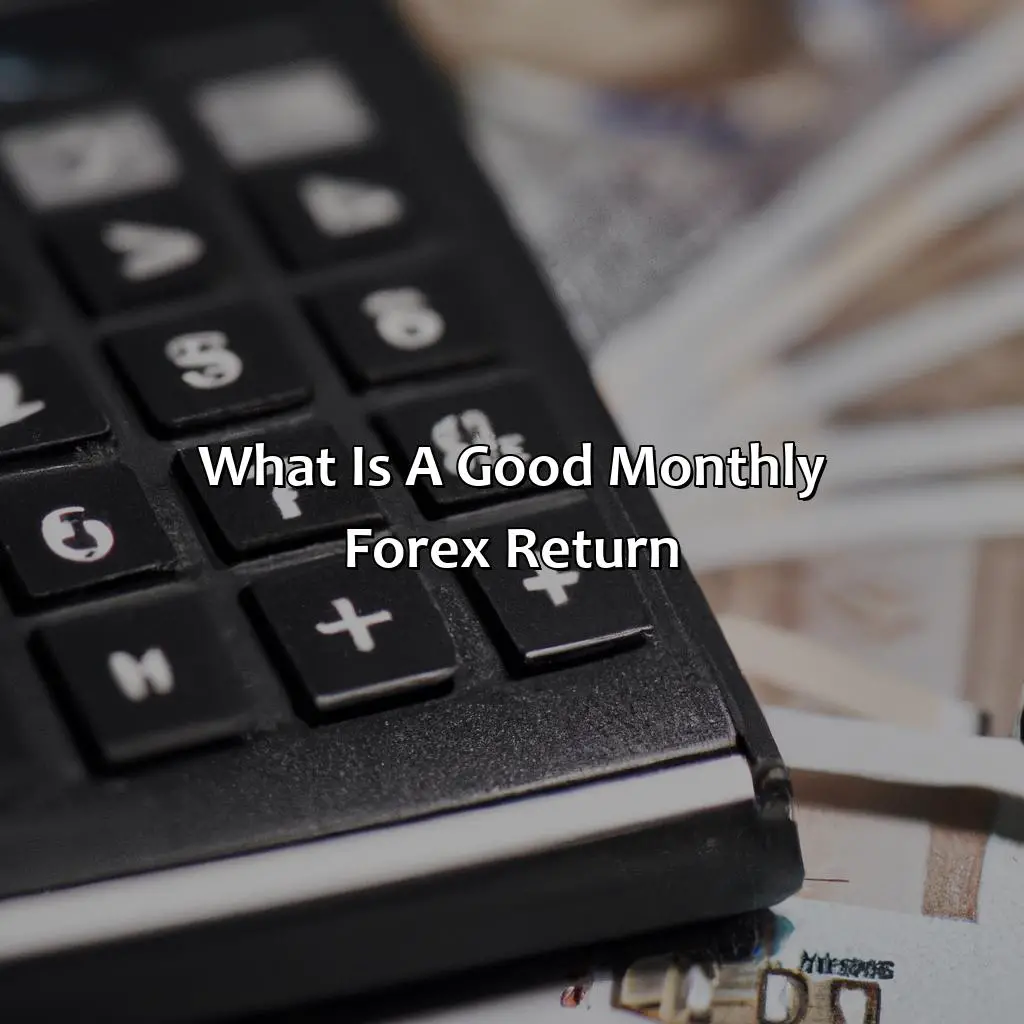
Key Takeaways:
- A good monthly Forex return is typically in the range of 1-10% and is relative to an individual’s financial goals and risk tolerance.
- Forex returns are influenced by factors such as market volatility, trading strategies, portfolio diversification, and risk management.
- Market volatility and risks should be taken into consideration when developing a trading strategy.
- Efficient Forex trading strategies and techniques such as stop-loss, trailing stops, and noting important news events can contribute to maximizing Forex returns.
- Portfolio diversification and risk management can lower risk exposure and enhance Forex returns by spreading risk among various investments.
- Realistic Forex return expectations can be set by properly understanding the market and its fluctuations, identifying personal financial goals and objectives, and analyzing trading patterns and historical data.
- Keeping abreast of Forex news and monitoring market trends can help traders maintain realistic Forex return expectations.
- Developing and adhering to a disciplined trading plan can help increase the chances of achieving a good monthly Forex return.
- Maintaining emotional control and avoiding greed are key factors in achieving a good monthly Forex return.
- Common mistakes to avoid when trying to achieve a good monthly Forex return include chasing quick profits and over-leveraging, neglecting risk management and portfolio diversification, and ignoring market trends and signals.
- Overall, a good monthly Forex return can be achieved by developing a disciplined trading plan, staying informed and updated on the market, and maintaining emotional control.
Defining a Good Monthly Forex Return
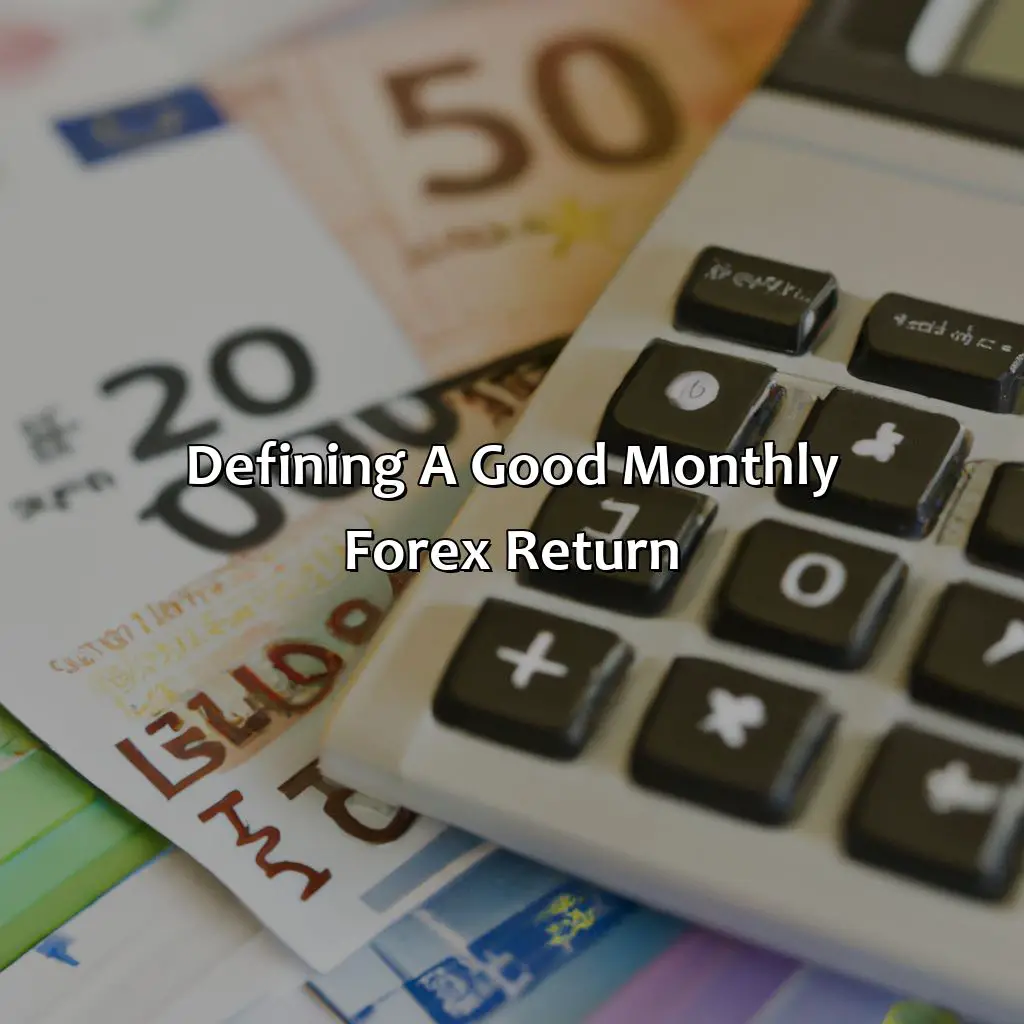
Photo Credits: forexbrokerreport.com by Brandon Nguyen
A good monthly forex return is determined by various factors, including market volatility, risk tolerance, and trading experience. The ideal return can vary depending on the individual’s goals and investment strategies. Achieving consistent profits with a low drawdown is generally considered a good monthly forex return. It is important to note that past performance is not always a guarantee of future success, and traders should continually monitor market conditions and adjust their strategies accordingly.
To maximize potential returns, traders must have a thorough understanding of technical and fundamental analysis. Using a combination of tools such as trend lines, moving averages, and candlestick patterns can help identify profitable trades. Additionally, keeping up with global economic events and news releases can provide valuable insights into market trends and potential opportunities.
Pro Tip: Always use risk management techniques such as stop-loss orders and position sizing to limit potential losses and protect profits.
Factors that Determine Forex Returns
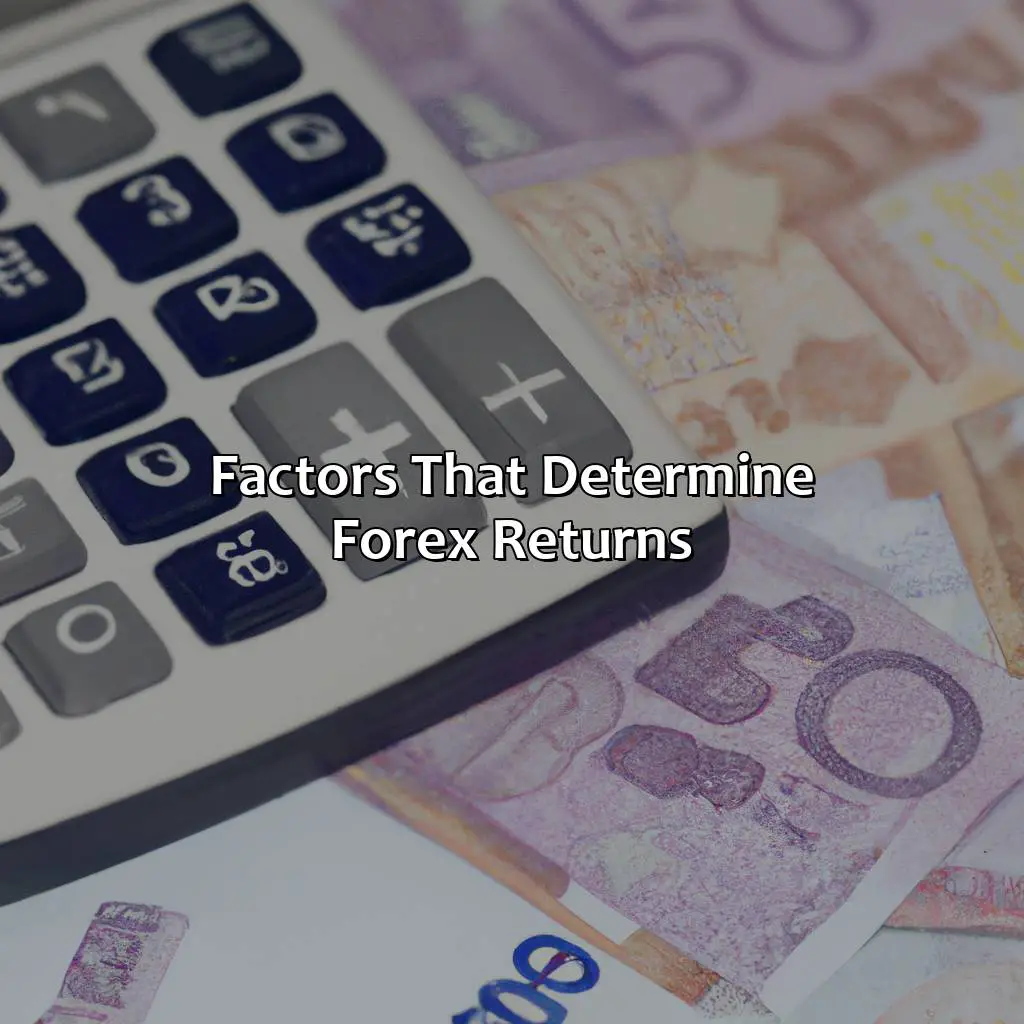
Photo Credits: forexbrokerreport.com by Steven Robinson
Want to know your monthly forex return? Analyze the factors that influence it. To understand market volatility and risks, trading strategies and techniques, portfolio diversification and risk management is key. These affect forex returns. Let’s explore their impact!
Market Volatility and Risks
The forex market is subject to continuous changes that may lead to high market volatility and potential risks for traders. The risks involve unpredictable price fluctuations, technological errors in trading platforms, and geopolitical events that impact currency values. As a result, traders should be prepared for the inherent risks of forex trading, including those arising from market volatility.
To manage these forex risks, traders must use various tools such as stop-loss orders, hedging techniques, and risk assessment methodologies. These strategies help to mitigate or eliminate losses caused by sudden market movements and unexpected news events. Moreover, portfolio diversification can also minimize risk exposure by investing in different asset classes across different markets.
In addition to market volatility and risks, traders must also consider other factors when setting realistic monthly forex return expectations. Factors such as their trading objectives and goals, analysis of historical data on past transactions, and understanding of the underlying market trends are also essential.
To achieve good monthly returns in forex trading, traders need to remain informed about the latest news on events affecting currency values and have a disciplined approach to executing trades consistently over time. Maintaining emotional control and avoiding greed is also crucial when managing investments in highly volatile markets like Forex.
While striving for good returns in Forex trading could be enticing traders often fall prey to common mistakes leading to substantial losses. Quick wins through aggressive leveraging come with potentially devastating results; ignoring risk management principles while concentrating all investments onto one stock means substantial adverse capital transfer costs; ignoring signals from an upward or downward trend could lead investors into disastrous positions ultimately leading them farther away from their set goals!
Thus it’s imperative that investors understand the notion behind each strategy implemented while overlooking contextual biases during application bringing them closer towards achieving long-term economic aspirations rightfully educated investors set themselves up at the forefront achieving their yearly financial goals!
Forex trading is like solving a puzzle; the right trading strategies and techniques will help you put the pieces together.
Trading Strategies and Techniques
Professionals employ tactics that allow for successful forex trading, such as the effective orchestration of trading strategies.
- Understanding Technical Analysis and Fundamental Analysis
- Implementing the Risk-Reward Ratio in Trades
- The Use of Stop-Loss Orders to Reduce Losses
- Creating a Trading Plan with Clear Exit Strategies and Analytical Techniques
- Regularly Adjusting Trading Strategies to Market Conditions
There are various considerations traders must keep in mind when choosing which trading strategy to use for their trades. Incorporating indicators, understanding market trends, and employing analysis tools can support successful forex trading. Traders may refine their assessments by considering factors such as historical data, currency correlations and news flows when selecting their trades. Additionally, strategizing should involve risk tolerance, financial goals at the forefront of choices made during forex trading.
Here are some suggested tips for effective implementation of winning strategies:
- Craft a Winning Trading Strategy Through Practice Sessions & Emotional Control Exercises
- Focus on Long-Term Planning Rather Than Short-Term Profitability
- Increase Your Knowledge with Government Economic Reports & Fundamental Analysis Results.
With alert attention focusing on indicators like moving averages or stochastic oscillators, traders can only look forward towards making profitable investments using sustainable trade control parameters which guard against potential losses. Spread your eggs across multiple baskets – portfolio diversification and risk management are key to successful forex trading.
Portfolio Diversification and Risk Management
Optimizing a Forex portfolio involves achieving the desired return while minimizing risk. Portfolio diversification and thorough risk management are essential in attaining this objective. Diversifying the portfolio by investing in different currencies can maximize returns and reduce potential losses. Risk management includes taking necessary precautions to mitigate risk factors, such as setting stop-loss orders, leveraging appropriate amounts and sticking to a trading plan.
Effectively managing risk means being aware of market volatility and creating strategies that minimize financial losses if the market fluctuates unfavorably. A well-diversified portfolio has a range of assets that respond differently to market elements, thus mitigating total exposure. Implementing technical analysis tools like indicators help to identify any early warning signals by tracking changing Forex trends which allow traders to make more informed decisions.
Ultimately optimizing returns depends on balancing risks with adequate returns; this can be achieved through careful portfolio management that minimizes vulnerability to downside risk during adverse market conditions while maximizing profits when there are positive market trends. By applying the principles of portfolio diversification, smart investment choices, and proactive risk management strategies, one can protect their portfolios against short-term price fluctuations whilst realizing long term profitability.
Setting realistic forex return expectations requires a balance of market knowledge and personal financial goals.
Setting Realistic Forex Return Expectations
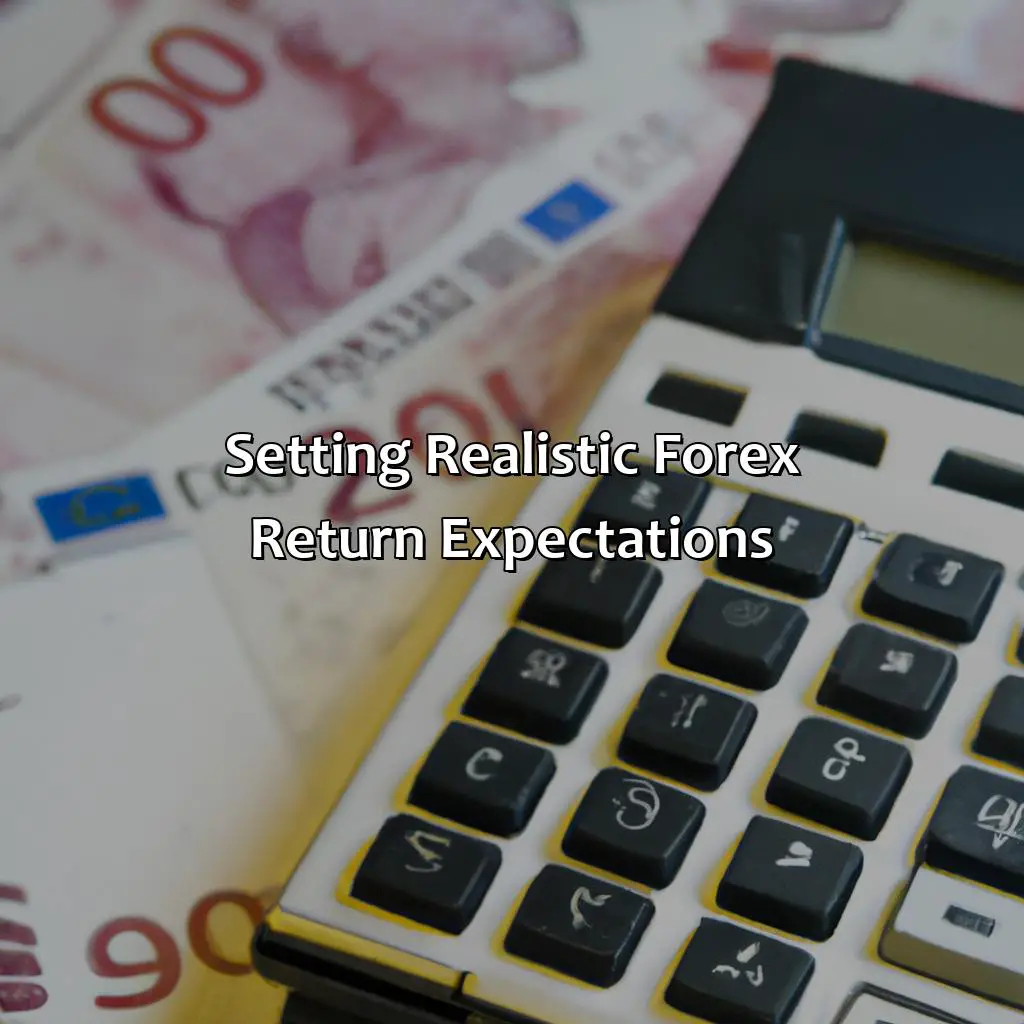
Photo Credits: forexbrokerreport.com by Gerald Nguyen
“What is a good monthly forex return?” is the article title for setting realistic forex return expectations. To do so, you need to understand the market and its movements. It’s also important to identify your financial goals and objectives. Analyzing trading patterns and historical data can help you make more informed decisions.
Understanding the Market and Its Fluctuations
The forex market is highly unpredictable, and making profits in it requires a deep understanding of market fluctuations. The trends and patterns are the result of several external factors, such as political news, economic indicators, and global events. Traders must closely monitor these changes to make informed decisions about their trades. By analyzing historical data and market trends, traders can also predict future moves to make better positions in the forex market. A well-informed trader who analyses this data has a greater chance of profiting from the forex market fluctuations.
Traders must interpret currency price movements accurately by studying technical analysis tools like charts, graphs, or indicators. Technical analysis reveals trends & patterns that clue investors on how markets might behave subsequently. These patterns are frequently formed due to fundamental factors such as economic data releases & surprising announcements about central bank policies.
Forex traders should learn all they can about the variables that influence the forex markets and work towards mitigating risks while optimizing gains through strategies taken to navigate any future perilousness in pricing shifts brought on by uncertainties tied with specific financial instruments or geopolitical events.
Through observation & participation, new traders can study alongside successful veterans whilst preventing common pitfalls like over-lending loans (referred to as over-leveraging) which may potentially blow up one’s entire capital account when trading significant leveraged volumes on tight stop loss conditions.
Once an investor has established what these external factors influencing the markets entail and successfully predicts how they will affect currency pairs’ pricing over time, early losses will soon give way to promising profits through continuous application of tried-and-true strategies used in online investments.
A seasoned investor recounts: ‘My experience in Forex trading was smooth, my monthly returns always steadily above 6%. It was turbulent earlier because I started with a low sum; I treated every trade with perspicacity & invested considerable effort watching out for shifts in macro-economics or country politicians statements until I grew my account.’
Your financial goals should shape your approach to forex trading, not the other way around.
Identifying Personal Financial Goals and Objectives
Understanding Personal Financial Objectives in Forex Trading
Setting up personal financial goals is crucial when it comes to achieving a good monthly forex return. Identifying and outlining these objectives allows traders to create a roadmap towards success and ensure they stay on track through that journey.
To start, forex traders need to establish what their financial aspirations are as it pertains to forex trading. This means identifying things like how much money they would like to make from forex, the timeframe in which they hope to achieve that, and where they see themselves in the market’s ecosystem.
Furthermore, personal finances should be taken into account with these objectives and avoided being too aggressive or capitalizing too quickly in order not to disrupt long-term growth potential.
By recognizing your desired outcomes for your investments and acknowledging any constraints you may have on achieving them, you are better able to see what type of trading strategy or approach is best suited for your specific situation.
When considering different strategies, a thorough analysis of previous trades can help inform what strategies will work best for obtaining the established financial goals. Creating realistic financial objectives with solid planning will set up traders for success by providing context against which progress can be charted and supportive methods determined.
Many successful forex traders have been guided by proper identification of their personal finances long before accumulating profits became paramount. By understanding your own needs and working within those parameters you can help minimize risks while positioning yourself optimally for returns towards your unique financial goals.
History may not repeat itself, but analyzing trading patterns and historical data can definitely give you a leg up in the forex market.
Analyzing Trading Patterns and Historical Data
Analysing historical trades and market information is a crucial part of forex trading. It helps traders to identify trends, patterns and opportunities to make strategic investment decisions.
Here’s an illustration of analysing trading patterns and historical data:
| Date | Pair | Strategy | Profit/Loss |
| 10/05/2021 | EUR/USD | Trend-following | +250 pips |
| 14/05/2021 | AUD/JPY | Fundamental analysis | -120 pips |
These insights can be used to make informed decisions when identifying entry and exit points, choosing the right trading instruments and setting risk management strategies.
It is important to use both qualitative and quantitative methods as they provide a comprehensive understanding of the market.
To improve trading outcomes, traders can compare past performance data against current trends in the market. This process involves identifying patterns in previous trades such as common triggers for profit or loss, using technical analysis tools like charts and indicators for pattern recognition, keeping an eye on major news events that may influence the currency markets.
Successful traders always learn from their past mistakes and revise their strategies based on their portfolio analysis.
Evaluate your plan regularly by monitoring factors like profits earned or losses incurred over a given period, comparing results with benchmarks or goals set previously, assessing how diversification affects returns.
Remember to keep risks at bay while incorporating new trading strategies basing on past analysis. Start by practicing in a demo account using historical data to familiarise yourself with the trading patterns and charts, create a solid plan with realistic targets, and remain disciplined in executing trades.
By using historical data for planning and analysis, traders can reduce risks while achieving consistent profits over time.
Stay informed and stick to your disciplined trading plan to achieve a good monthly forex return, but don’t forget to maintain emotional control along the way.
Tips for Achieving a Good Monthly Forex Return

Photo Credits: forexbrokerreport.com by Alan Carter
To get a good monthly forex return, staying informed on forex news is a must. Create a disciplined and consistent trading plan. Plus, emotional control and no greed are essential. We’ll look at the perks of knowledge, how to make a plan, and how to keep emotions under control in this section “Tips for Achieving a Good Monthly Forex Return.”
Staying Informed and Updated on the Market
Keeping up-to-date with the latest developments in the forex market is crucial for achieving an optimal return. To remain updated, it is necessary to stay informed about the latest news and trends across various platforms. Being proactive and keeping track of major events can help traders make timely decisions that influence their profitability. For instance, staying up-to-date on political events, including elections or geopolitical tensions, may affect exchange rates. There are several sources of information available, including financial news outlets, online forums and social media groups where traders share market insights. Subscribing to newsletters and relevant trade publications can also provide useful information.
Moreover, regularly seeking out authoritative and reliable sources of forex news can help traders stay informed about economic indicators, central bank policies and interest rate movements that could potentially impact their trades. Being aware of such impactful developments – both domestically and globally – can provide insights into how certain assets may react in specific market conditions.
To ensure they have all the information they need to succeed in forex trading strategies must continually work out ways to keep tabs on market hotspots through different channels. Forecasts should consider varying factors that come into play within the Forex world to mitigate like Oil prices fluctuation.
Many successful traders will attest that staying abreast global trading news allows them ping signals on profitable deals as well as anticipate any potential aspects that could result in significant losses. For instance, when China devalued its currency between 2015-2016 many made a killing from betting against the Yuan.
In summary, for successful forex trading who desire high returns at recurring intervals having access to breaking stock market news feeds high up there with other indispensable aspects such as top-rated brokerage accounts, proper planning and strategy development towards achieving set objectives.
Discipline isn’t just for athletes: a disciplined trading plan is key to achieving consistent success in the forex market.
Developing a Disciplined and Consistent Trading Plan
Developing a consistent and disciplined strategy is crucial for success in forex trading. This involves devising a plan that outlines entry and exit points, risk management strategies, and positions sizing. By adhering to such methods, it allows for objectives to align with actions, thus increasing the probability of achieving profitable yields. Keeping an ongoing journal helps monitor progress towards these goals. It’s important to have a flexible attitude and improve processes as markets alter.
Pro Tip: Incorporate news-based trading events into your plan to stay informed about market conditions.
Don’t let greed drive your forex trading decisions – emotional control is key for success.
Maintaining Emotional Control and Avoiding Greed
Maintaining a stable mind and steering clear of avarice while trading Forex is crucial to achieve consistent profits. Emotional control aids traders in staying centered, and adhering to pre-determined trading rules prevents mistimed decisions that often lead to losses. Avoiding greed keeps traders from chasing quick profits that could result in overleveraging, resulting in disastrous losses.
To maintain emotional control and avoid greed, it is essential to establish a well-thought-out trading plan based on careful analysis and realistic expectations. This involves setting goals, deadlines, stop-losses, and profit target levels before entering trades. Traders must also identify their risk tolerance level before placing bets to stay disciplined during market swings.
Additionally, traders should avoid becoming overly attached to their positions or feelings of invincibility after experiencing success. They should maintain a healthy balance between confidence and humility to minimize risks effectively.
Pro Tip: Keeping frequently updated record books can help traders manage their emotions throughout the trade’s duration by reducing stress levels while making rational decisions based on historical data.
Don’t fall prey to the temptation of quick profits, the true key to success in forex is risk management and keeping an eye on market trends.
Common Mistakes to Avoid When Trying to Achieve a Good Monthly Forex Return
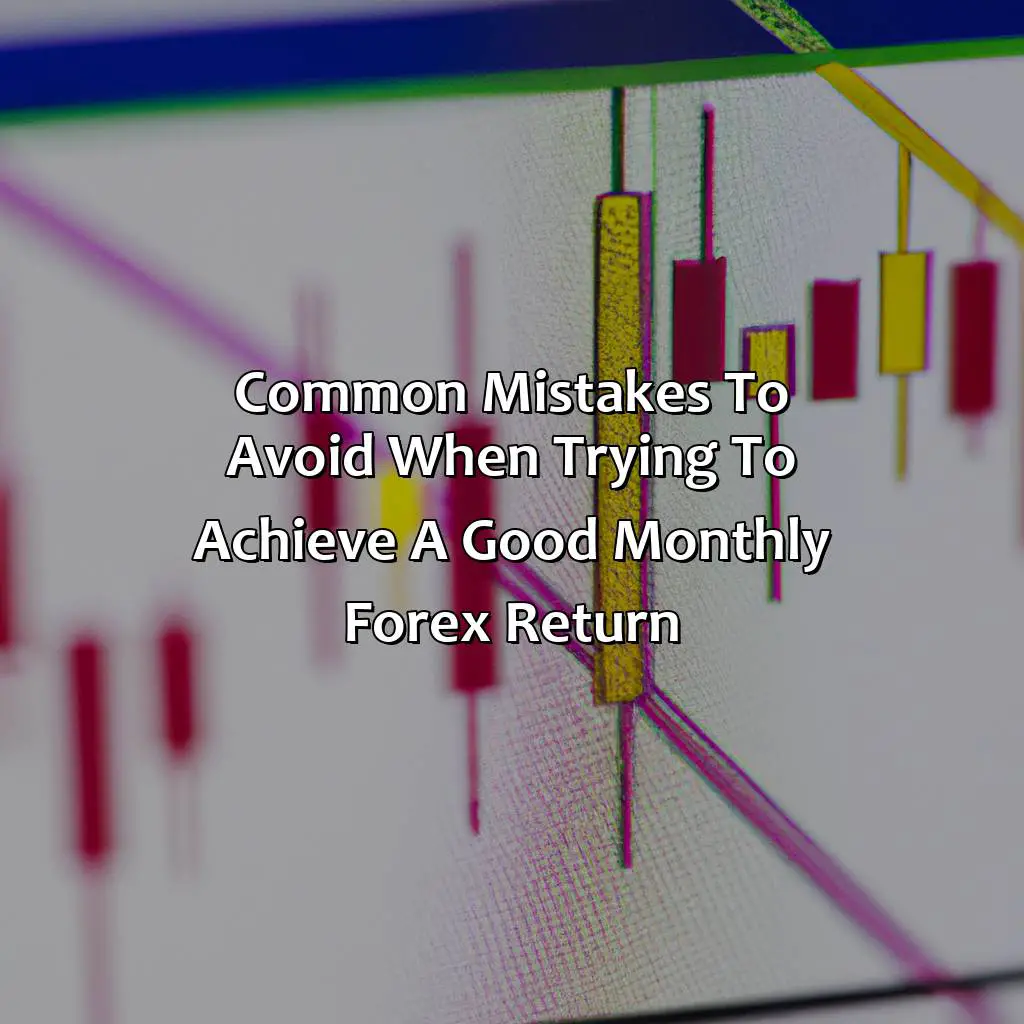
Photo Credits: forexbrokerreport.com by Frank Brown
Don’t make silly mistakes when pursuing a great forex return each month! Look into these topics:
- “Chasing Quick Profits and Overleveraging”
- “Neglecting Risk Management and Portfolio Diversification”
- “Ignoring Market Trends and Signals”
These will show you the risks and what to think about when making a long-term forex investment plan.
Chasing Quick Profits and Overleveraging
In the world of forex trading, the temptation to chase quick profits and overleverage can be strong. This refers to making hasty and impulsive trades in the hopes of making a quick profit, often using borrowed funds that exceed account value. However, this approach is fraught with risk and can lead to significant losses.
Chasing quick profits and overleveraging increases the chances of losing money rather than achieving a good monthly forex return. It encourages traders to rely on luck rather than sound trading strategies, which can lead to inconsistent or erratic trade patterns.
Furthermore, overleveraging not only increases risk but also limits opportunities for recovery. One major loss could take out a significant portion of an account’s available capital, leaving little room for future trades.
Traders who aspire to achieve a good monthly forex return need to avoid such reckless practices. Instead, they should focus on developing disciplined and consistent trading plans based on thorough research and analysis.
Therefore, fear of missing out (FOMO) should not influence traders’ decisions as there are no shortcuts to success in forex trading. By prioritizing patience and strategy over shortcuts, traders increase their probability of achieving sustainable profitability over time.
Neglecting risk management and portfolio diversification in forex trading is like jumping out of a plane without a parachute – it may feel exhilarating at first, but the crash landing can be devastating.
Neglecting Risk Management and Portfolio Diversification
Neglecting crucial aspects like risk management and portfolio diversification can have disastrous consequences when trading in the forex market. In addition to unpredictability in exchange rates, foreign currency trading involves high volatility and risk. Without an adequate strategy for managing these risks, traders can experience significant losses or even wipe out their entire trading account. Similarly, a lack of portfolio diversification amplifies the impact of unexpected market movements, further weakening one’s risk profile. It is essential to prioritize both risk management and portfolio diversification to mitigate potential losses while seeking profitable trades.
While traders often seek quick profits and may neglect proper risk management and portfolio diversification, adopting a solid foundation for maximizing returns must take precedence over chasing short-term gains. Strategies such as setting stop-loss limits, adhering to strict trade-recovery plans, and avoiding overleveraging help manage risks effectively. Diversifying your portfolio across different forex pairs or asset types further enhances your potential for stable returns.
To avoid risking your trading capital in the highly volatile forex market, it is critical to stay disciplined with cautionary measures at all times. By keeping a close eye on emerging patterns and signals from current trends or new developments within the industry, you can minimize the likelihood of suffering losses too great to recover from.
According to Investopedia, not understanding the importance of risk management ranks among the top reasons beginner traders fail in forex markets.
Don’t ignore market trends and signals, unless you enjoy playing a risky game of forex roulette.
Ignoring Market Trends and Signals
Traders who ignore market trends and signals are at risk of significant financial losses. Failure to monitor market movements and heed the warnings provided by various indicators can jeopardize profits and even result in complete failure. It is essential to keep track of price fluctuations, technological advances, economic policies, and other factors that influence a currency’s value before making any trading decisions.
By being mindful of current market trends and signals, traders can extract valuable insights on entry points and exit strategies for trades. New technologies such as software programs that analyze historical data can help predict future trends in the forex market, leading to better-informed decisions. Failure to incorporate such resources into your trades may lead to sub-optimal results.
Ignoring market trends and signals is an easy mistake to make for novice traders who become overly invested in their trading strategies. However, seasoned traders recognize the importance of paying attention to these critical concepts while remaining flexible enough to adjust their trading methods accordingly.
According to Investopedia, more than 80% of retail forex traders lose money every year because they disregard important market conditions. This highlights the significance of considering fundamental external factors when developing trading strategies like keeping an eye on current trends and signals.
Five Facts About What Is a Good Monthly Forex Return:
- ✅ A good monthly forex return is subjective and can vary depending on the investor’s goals and risk tolerance. (Source: Investopedia)
- ✅ Professional forex traders aim for a monthly return of 1-10%, while conservative traders may aim for 0.25-1%. (Source: My Trading Skills)
- ✅ Forex trading carries a high level of risk, and investors should not expect consistent monthly returns. (Source: FXCM)
- ✅ An individual’s experience and skill level can impact their ability to achieve a good monthly forex return. (Source: DailyFX)
- ✅ It is important to have realistic expectations and not chase unrealistic returns, which can lead to financial losses. (Source: The Balance)
FAQs about What Is A Good Monthly Forex Return?
What is a good monthly forex return?
A good monthly forex return will depend on several factors such as economic factors, political factors, and social factors. It is essential to maintain consistency in forex trading to achieve a good monthly return.
What economic factors affect monthly forex returns?
The economic factors that affect monthly forex returns are inflation rates, GDP, employment rates, and fiscal policies. The forex market is heavily influenced by economic indicators.
How do political factors affect monthly forex returns?
Political factors such as elections, geopolitical tensions, and policy changes can significantly impact monthly forex returns. Forex traders need to monitor such events and adjust their trading strategies accordingly.
What social factors can impact monthly forex returns?
Social factors such as consumer confidence, public health, and cultural events can impact monthly forex returns. These factors can indirectly affect the market’s sentiment and create trading opportunities.
Why is consistency important in achieving a good monthly forex return?
Consistency is crucial in forex trading because it helps develop a sound trading strategy, reduces emotional trading decisions, and builds discipline. A consistent approach can help traders produce a sustainable and good monthly forex return over the long term.


